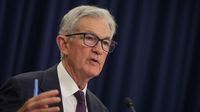The Federal Reserve’s decision to cut its benchmark interest rate by 0.25 percentage points on September 18, 2025, marked its first such move in nine months, sending ripples through financial markets and raising fresh questions for American consumers, businesses, and policymakers. The cut, which lowered the federal funds rate to a range of 4.00% to 4.25%, comes amid mounting economic uncertainty, persistent inflation, and growing political pressure from President Donald Trump for more aggressive action to boost the economy.
At a press conference following the announcement, Fed Chair Jerome Powell described the move as a “risk management” rate cut, emphasizing that the central bank is navigating a tricky landscape. "Job gains have slowed, and the unemployment rate has edged up but remains low," the Federal Open Market Committee stated, while noting that "inflation has moved up and remains somewhat elevated." According to Axios, inflation is hovering around 3%, still above the Fed’s target of 2%, and the labor market is showing signs of strain with payrolls rising by just 22,000 in August and unemployment ticking up to 4.3%.
Despite the headlines, many Americans are wondering: how soon will this rate cut affect their wallets? The answer, according to experts interviewed by ABC’s WPVI and Bankrate, depends largely on the type of debt or savings you hold. Credit card holders could see small reductions in their rates within one to two billing cycles, offering a bit of relief to the nearly half of Americans who carry balances month-to-month. Stephen Kates, a financial analyst at Bankrate, explained, "Somebody who might be carrying a balance on a credit card, you might start to see the rate change within one to two billing cycles." Similarly, rates on home equity lines of credit—also variable—are likely to decrease within a month or two.
For those eyeing a new car or looking to refinance an auto loan, the impact is less direct. Auto loans are typically fixed, so existing borrowers won’t see an immediate change unless they refinance, which may not always be cost-effective due to origination fees and minimal monthly savings. As Bankrate points out, auto loan rates are also influenced by borrower creditworthiness, vehicle type, and even the time of year, making the connection to Fed policy less straightforward.
Mortgage rates, meanwhile, are at the center of national attention, especially as housing affordability remains a hot-button issue. But here’s the catch: mortgage rates aren’t directly tied to the federal funds rate. As Northeastern University economist Bob Triest told Northeastern Global News, "The cut yesterday will have essentially no effect." He explained that mortgage rates are more closely linked to the 10-year Treasury yield, which is shaped by investor expectations for future short-term rates, economic growth, and inflation. "When they borrow for long-term investments, including mortgages, the cost of money is priced off the 10-year Treasury yield," echoed Fannie Mae’s Nathaniel Drake in a December analysis cited by Axios.
Still, the Fed’s move—and its signals about future cuts—can influence mortgage rates over time. The central bank’s updated projections, or "dot plot," released Wednesday, indicated that two more rate cuts are likely by the end of 2025, with a further reduction expected in 2026. This would bring the federal funds rate closer to 3%, a level that Triest believes "will be enough to substantially lower mortgage interest rates." He added, "I expect that before the end of 2025, we’ll see mortgage rates drop measurably. How much, I don’t know." Already, the average 30-year mortgage rate has fallen to 6.35%, its lowest level in nearly a year, according to Freddie Mac, as reported by Axios.
But the path forward is anything but certain. The Fed faces a delicate balancing act: it wants to stimulate the economy and shore up a labor market some analysts are calling a “jobless expansion,” but must do so while inflation remains stubbornly high. The situation is further complicated by President Trump’s tariff policies and the passage of the Big Beautiful Bill Act, which has increased public debt projections and may push up government borrowing costs, potentially offsetting the downward pressure on interest rates. "By moving to shore up the economy, the Fed is putting less emphasis on bringing down inflation than it has been in the recent past," Triest observed. "So that might spark a fear of higher future inflation that will tend to push up longer-term interest rates like the 30-year mortgage rate."
Political drama is never far from the Fed’s deliberations, especially with the central bank’s independence in the spotlight. President Trump has been vocal in his demands for deeper, faster cuts, and recently installed his top economic adviser, Stephen Miran, as a Fed governor. Miran made headlines by casting the only vote for a 50 basis point cut at this meeting—an unusual move, given that he is the first official in nearly 90 years to serve in both the executive branch and the Fed, raising questions about potential conflicts of interest. Fed Chair Powell was quick to reiterate, according to Quartz, that "political considerations belong elsewhere in Washington, and are not the concern of the central bank."
For savers, the news is less rosy. Interest rates on savings accounts and money market funds will likely decline, reducing yields for those who rely on these vehicles for income. "One person's borrowing is somebody else's saving, and the yield for something like a money market mutual fund is going to go down and already has once the Federal Reserve's near-term plans became clear," said Matt Colyar, an economist at Moody's Analytics, in comments to WPVI. Certificates of deposit (CDs) and bonds will also be affected: existing CDs and bonds retain their fixed rates until maturity, but new offerings will reflect the lower rate environment. Notably, the market value of existing bonds typically rises when rates fall, benefiting those who sell before maturity.
Despite the modest size of the cut, the move was widely anticipated by markets. The S&P 500 had already climbed to record highs earlier in the week, and major indices moved only modestly after the announcement, according to Quartz. Prediction markets now see further cuts in October and December as likely, with some Wall Street economists even forecasting a rate cut at every Fed meeting through January.
With so many moving parts—economic, political, and personal—it’s no wonder that financial experts urge caution. "Whether you're borrowing, whether you're saving, whether you are investing, your strategy should be the same. Have a long-term view of how you manage your finances and the best thing you can do is spend less than you make. Pay down high interest debt and invest in the future," advised Kates of Bankrate.
For now, Americans will have to watch and wait as the effects of the Fed’s latest move ripple through the economy, with the only certainty being that the debate over interest rates—and the future of the U.S. economy—remains far from settled.


